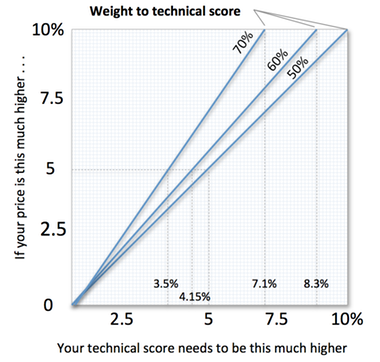Although our posts focus mainly on differentiating and presenting your proposal’s technical offer, we’d never suggest price is unimportant.
Even in the case of two-envelope RFPs, where prices are revealed only after the narratives are scored, price looms large in the final decision. This is true even when the narrative sections are weighted at more than 50% of the total.
The chart below shows the narrative points advantage you need to prevail (expressed as a percentage of the total) if your price is anywhere up to 10% higher at various weightings.

In competitive situations, bidders are unlikely to overcome a price disadvantage of 5% or more.
Favouring price
If a buyer is determined to award to the lowest priced bidder—whether due to budget pressures, or to avoid protests or public scrutiny—there are at least three ways to accomplish this.
- Adjust technical scores after the price envelopes are opened (This is unfair and/or illegal—but it happens.)
- Score the technical narratives in a very narrow range, so the lowest price is likely to prevail, despite the relative weighting scheme
- Structure the RFP rules so the lowest qualified bid wins
The good news is, most buyers are looking for value and strategic fit, not just the lowest price.
Also, nearly every bid we’ve supported has been run fairly. In fact, evaluation teams for large government bids typically include an independent monitor responsible for ensuring a fair process.
Still, as a key element of your offer, price deserves the same attention to expressing value as do the sections devoted to your understanding, solution, experience, team and implementation plan.
Presenting and positioning and your price
This month, we’ll look at ways to help evaluators understand how you reached your price, why it is reasonable—and proof you can deliver within it. This will include ideas in two areas:
- Presenting: Most bidders limit price presentation to completing the issuer-supplied forms. But—especially for multi-phase projects and complex blended pricing situations—we’ll suggest other approaches.
- Positioning: Every technical narrative reflects choices made when developing an offer. Many of these will differ from your competitors’ decisions and will impact price. It’s important to make your trade-offs visible and to justify them.
Added benefit: By making the effort to present and position your price, you and your team will gain new perspectives on decision making that impacts costs and pricing. This may well lead to adjustments in your process that improve your chances of winning.


